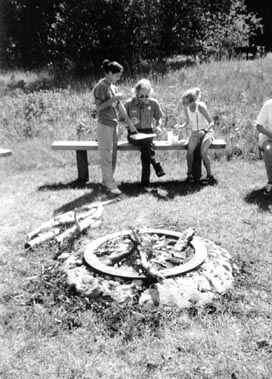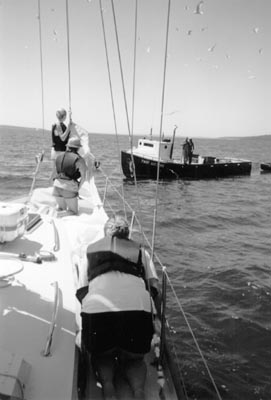 "I call the jib!" "I call the mizzen!"
"I call the jib!" "I call the mizzen!" by Capt. Joan Gilmore
 "I call the jib!" "I call the mizzen!"
"I call the jib!" "I call the mizzen!"
Shouts come back from the foredeck as we approach our anchorage at Julian Bay in the Apostle Islands of Lake Superior and the crew of six teenagers mobilize to take down sails and prepare to anchor.
For most of them, this is their first experience on a keelboat, and for many, the first time they have been sailing. But by the third day, everyone is familiar with rigging the sails on our 42 foot ketch, including hanking on and flaking our 150 jib before preparing to anchor. The three sails give everyone a job to do, with two kids raising or lowering each sail.
Our crew is comprised of campers from YMCA Camp St. Croix in Hudson, Wisconsin. The camp runs a sailing program from their base on Lake St. Croix with two keelboats and 20 smaller boats. From there, kids may opt for a 5-9 day "trail" experience away from camp on the camp’s boat, "Gavia" on Lake Superior. "Gavia," which means "Loon" in Latin, was donated to the camp 15 years ago and has become a popular option for campers from ages 13-17.
When the group of six campers and their counselor arrive on the first day of their trip, typical questions include "Can this boat tip over?" and "What will we do if it rains?" As they go through orientation, concerns become "Who has to be the man overboard during the man overboard drill?" and "Where’s the microwave?" (Though well-equipped, Gavia relies solely on LP for cooking.)
Once we’re underway, questions move toward "Is it going to rain?" and the frequently asked question when boarding the dinghy, "Should I wear socks?" These questions become a lesson on use of the marine radio to get the weather report and the opportunity to learn to read the barometer. As we set sails and the crew settles into a rotation of cockpit crew, helm, foredeck crew and lookout, the question becomes, "When are we going to get there?" This question becomes our first lesson in navigation as we bring out the chart, dividers, parallel rules and GPS to help us pinpoint our position after we estimate where we are through dead reckoning. We fix on our destination for the night’s anchorage, squiggle a line across the chart to replicate the tacks we’ll need to make, and come up with the distance we’ll be traveling. From there we can estimate our speed and our time of arrival. During night sails, we will figure out our course to steer and check our progress every hour.
Night sails are a special treat. Organizing themselves into watches, the crew brings their sleeping bags into the cockpit and brews kettles of hot chocolate to watch the stars come out, struggling to stay awake long enough to witness the sun rise over the open lake. Sometimes, on these passages to Grand Marais or the Baptism River on the north shore, the fog will roll in, making us feel very alone as we cross the shipping lanes. To let our passing neighbors know this isn’t the case, we bring out the "party horn." This is our big shiny mouth horn that the crew member with the biggest lungs gets the honor of blowing every two minutes.
 |
Ranger Jim Huot-Vickery with campers Lindsey Nelson and Berit Nelson at South Twin Island fire pit working on Jr. Ranger awards. |
As we pass other boats, the kids clamor to call them on the radio. At this point they learn about use of channel 16 and emergency procedure protocol. During the course of a trip, the crew may make a connection with another boat or earn their "Junior Ranger" awards from a National Park Service ranger on one of the islands. This gives them the opportunity to make a VHF call to thank the ranger or ask for a report on anchorage conditions in their area.
A large part of the experience for the teenage crew members is making social connections and learning to get along in close quarters. Most of these kids come from the suburbs of St. Paul, Minnesota, so typical discussions between them will compare schools, sports teams they play on and family situations. As we relax at anchorage, the discussion about "What I want to be when I grow up" frequently arises. One tall girl wants to be a professional hockey player. If not, a defense attorney, like her dad. Several in the group want to be social workers. Veterinary medicine is a popular choice. And, every other trip, one of the kids, usually a girl, states that she wants to get her captain’s license!
Living in close quarters, friendships are forged through preparing meals together. "Now I can really appreciate how much work it takes for my mother to do the cooking." This comment from the kid who originally asked the question, "Where’s the microwave?" The trauma of fixing a stopped up head also provides lasting memories and some very expressive journalism in "Boating Memories," the boat’s informal ship’s log into which all crew members contribute.
 |
(from top)Berit Nelson, Megan Byrne and Counselor Annie Hewitt and “Twin Sisters’”fisherman Hooper with crew(right). |
The physicality of sailing sometimes takes some getting used to for kids raised in the digital age. Where some may prefer at first to steer by the compass, they gradually get used to steering to a point on land, and then steering to optimize the wind, so that, before long, shouts of "We’re going 8.8 knots!" rises from the cockpit, and in an even higher pitched voice, "9.4!!" As I watch a 13-year old crew member swivel the chair at the helm in order to lock the wheel so that he can singlehand the jibsheets for a tack, I know that a new solo-circumnavigator has been born.
At the beginning of their trip, each group is introduced to a five-category merit award system that recognizes the skills learned during the course of the trip. Some new sailors immediately state, "I want to get every one of them." With a goal to work toward, most crew members learn all the knots on the list ranging from the slip knot, clove, rolling and half hitches to the cleat, stopper knot and the one-handed bowline.
Everyone is part of the anchoring process, from lowering the anchor to being the "ship’s parrot" who stands near the helm to repeat all communication from the anchor crew to the helm over the noise of the wind and engine. And once the anchor is set, all crew members help to "sight the land" as the anchor is tested under power. Bearings are then taken of the boat’s position, as the most avid young crewmember volunteers to wake up in the middle of the night to check the boat’s position.
After the journey ends, and we are back in port, the kids’ feeling of ownership shows itself as they clean the boat and prepare to return to camp. Kids offer to do extra things for the boat, like caulk seams and oil wood. Some leave little presents for the next campers and ask questions like, "When was THIS last washed?" A proud anchor handler lifts the anchor locker door to show off her perfectly coiled rode.
Some of these kids will become sailing counselors in the coming years or volunteer to help with spring cleaning of the "Gavia" during work weekends. And many of them will become great sailors some day, sharing their love of the sport with future generations.
Lake Superior group sailing aboard "Gavia" is available for 1998. Capacity is limited to six people (including leader). Call YMCA Camp St. Croix for details/reservations. 612-436-8428 or 715-386-4380.
All contents are copyright (c) 1998 by Northern Breezes, Inc. All information contained within is deemed reliable but carries no guarantees. Reproduction of any part or whole of this publication in any form by mechanical or electronic means, including information retrieval is prohibited except by consent of the publisher.